Attitude: Ethics- 1 | UPSC Mains: Ethics, Integrity & Aptitude PDF Download
Defining Attitude
- Attitude is defined differently by social psychologists. "An attitude is a mental and neural state of readiness, organised through experience, exerting a directive or dynamic influence upon the individual's response to ill objects and situations with which it is associated," wrote Gordon Allport.
- In simple words, Attitude is a way of looking at any situation and deciding, either consciously or unconsciously – how we relate it to ourselves and others. It can be something to do with our personality and experience. The significant positive attitudes include being frank, confident, jealous, respectful, sincere, honest, hard working, faithful, loving, flexible, humble, helping, independent, sympathetic, hard working etc.
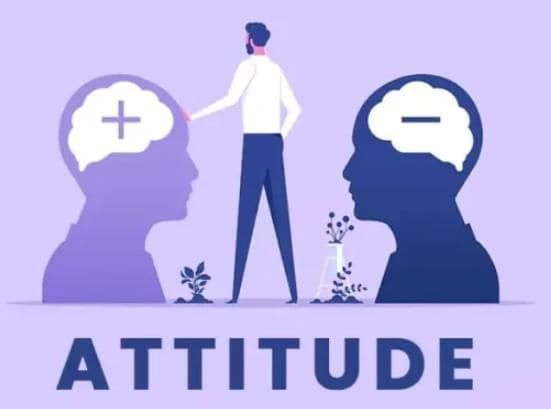
Thus, Attitude means how we feel, think, and act towards people, ideas, or things. It can be positive or negative and often depends on our values and beliefs.
Beliefs come from past experiences (even if we don’t remember them) and shape how we see the world. They guide our actions and are a key part of who we are — whether they are religious, cultural, or moral.
Classification of Attitude
- Explicit: Explicit attitudes are those that a person is fully aware of. These attitudes are formed consciously and play a significant role in shaping behavior and beliefs. For example, if someone consciously believes that exercise is essential for good health, this explicit attitude will likely influence their behavior, such as going to the gym regularly.
- Implicit: Implicit attitudes, on the other hand, operate at a subconscious level. A person may not be aware of these beliefs, but they still influence actions and behaviors. For example, an individual might have an implicit bias against a particular group of people, which affects their behavior towards members of that group without them realizing it.
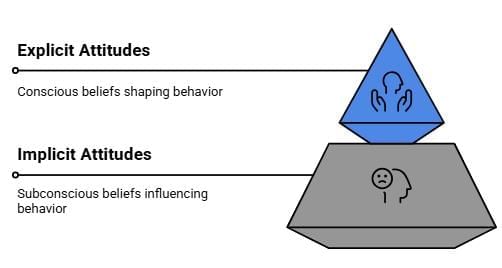
Why it is important to cultivate the Right Attitude in our lives?
- Attitude defines life and life defines attitude.
- Dalai Lama has said: If you can cultivate the right attitude, your enemies are your best spiritual teachers because their presence provides you with the opportunity to enhance and develop tolerance, patience and understanding.
Components of Attitude
An attitude is made up of three interconnected components: cognitions, emotions and behaviours.
1. Cognitive:
- This component refers to the process of acquiring knowledge through reasoning, intuition, and perception.
- It encompasses a person's thoughts and beliefs about the object of their attitude.
- For example: I believe spiders are dangerous.
2. Behavioural (Conative):
- Also known as the conative component in psychology, it refers to the aspect of attitude that involves willpower, such as impulse, desire, or resolve.
- For example: I will avoid spiders and scream if I see one.
3. Affective (Emotional):
- This component involves the feelings that a person experiences towards an object, issue, or event.
- For example: I am scared of spiders.
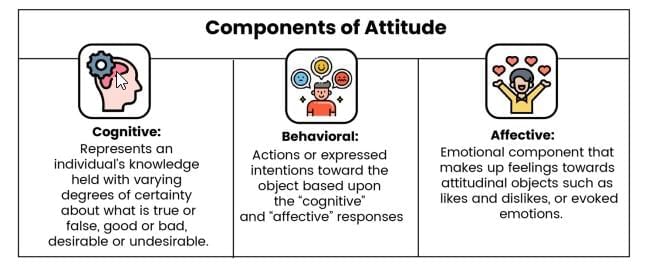
Functions of Attitudes
Attitudes play a crucial role in guiding our thoughts, behaviors, and interactions with the world around us. Here are the key functions of attitudes:
1. Adjustment
- Attitudes guide our responses and behaviors, helping us align with our goals and priorities.
- They summarize our feelings, thoughts, intentions, and behaviors, shaping our interactions with others and our environment.
- Attitudes help us navigate uncertainties by providing cognitive structures that fill in gaps in information.
2. Ego Defensive
- Attitudes serve to protect us from fears and anxieties by influencing how we perceive threats and challenges.
- They can shield us from recognizing thoughts or feelings that might challenge our self-image or personal beliefs.
- Ego-defensive attitudes act as a psychological defense mechanism, preserving our sense of self-worth and identity.
3. Knowledge
- Attitudes categorize and simplify our understanding of the world, helping us interpret and make sense of people and objects.
- They serve a heuristic function by providing efficient ways to evaluate and navigate our environment.
- Attitudes are linked to stereotypes, which can evoke intense emotions and sometimes lead to intergroup conflict.
4. Value Expression
- Attitudes express our fundamental values and beliefs, allowing us to articulate what is important to us.
- They help us communicate our identity and reinforce our self-image by aligning our behaviors with our values.
- Value-expressive attitudes enable us to convey our preferences and priorities in personal and social contexts.
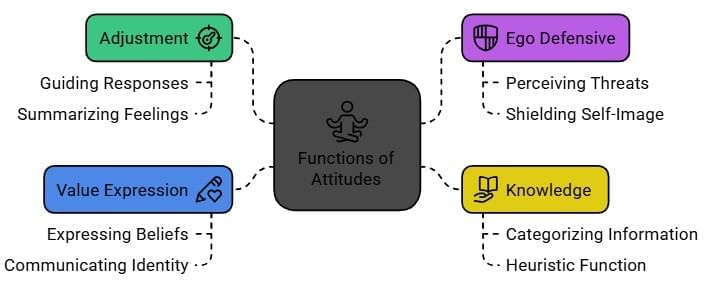
What are the Causative Factors behind the Formation of Attitudes?
1. Culture
- Culture plays a crucial role in shaping individuals.
- It includes aspects like religion, traditions, customs, prohibitions, rewards, and sanctions.
- Socialization is the process through which culture influences people’s attitudes.
- Culture teaches what is considered acceptable in terms of beliefs, attitudes, and behaviors within society.
- For example, in India, the consumption of beef is often considered taboo due to religious beliefs, whereas in many Western countries, there are no such restrictions.
2. Family
- The family is the closest and most influential social group for an individual.
- It is the primary unit where attitudes are formed.
- Parents are the most significant influence on a child’s attitude development.
- The extended family and relationships with siblings also contribute to attitude formation.
3. Social Groups
- Other social groups, such as friends, peers, and colleagues, also play a role in developing attitudes.
- For instance, in India, some people may not pay attention to political speeches or media but rely on discussions with friends and family to make decisions, such as voting.
- These social groups can significantly impact choices and preferences.
4. Institutions
- Throughout life, individuals are influenced by various institutions.
- Educational institutions like schools and colleges, for example, play a vital role in shaping beliefs and values, which in turn form attitudes.
5. Familiarity
- Familiarity often leads to a positive attitude.
- People tend to feel more comfortable with what they know, as the unknown can be intimidating.
- Familiarity, along with classical conditioning, can influence emotions and shape the emotional component of attitudes.

Formation of Attitude
Attitude formation is the process of developing a positive or negative feeling toward a person, object, or idea. It starts from having no opinion and gradually builds through different sources. The key sources include mere exposure, direct experiences, and social learning. Mere exposure means that just being around something repeatedly can lead to a liking for it. Direct personal experiences are even more powerful, as they can strongly shape and even change our attitudes. Social learning, or observing others' actions and reactions, also plays a significant role in how our attitudes are formed.
Interconnectedness of Attitude Formation and Change
1. Continuous Process: Attitude formation and change are intertwined processes where individuals adopt, modify, or discard attitudes based on evolving needs and interests.
2. Acceptance Factors: Acceptance of new attitudes depends on:
- The credibility of the communicator.
- How the message is presented.
- How it is perceived by the recipient.
- Contextual factors influencing the reception of information.
3. Attitudes change when:
- A person receives new information from others or media - Cognitive change
- Through direct experience with the attitude object - Affective change
- Force a person to behave in a way different than normal - Behavioural change
What are the Techniques to Bring Change in Attitude?
Attitudes can indeed be shaped and learned through various psychological processes, including classical conditioning, operant conditioning, and observational learning:
1. Classical Conditioning in Attitude Formation
- Classical conditioning is a process where a neutral stimulus becomes associated with an emotional response by being paired repeatedly with a stimulus that already triggers that response.
- Example: Advertisers often use classical conditioning in commercials to influence attitudes towards products. For instance, Axe commercials associate their products with desirable qualities like attraction and romance ("The Axe Effect"), linking their brand with positive emotional responses.
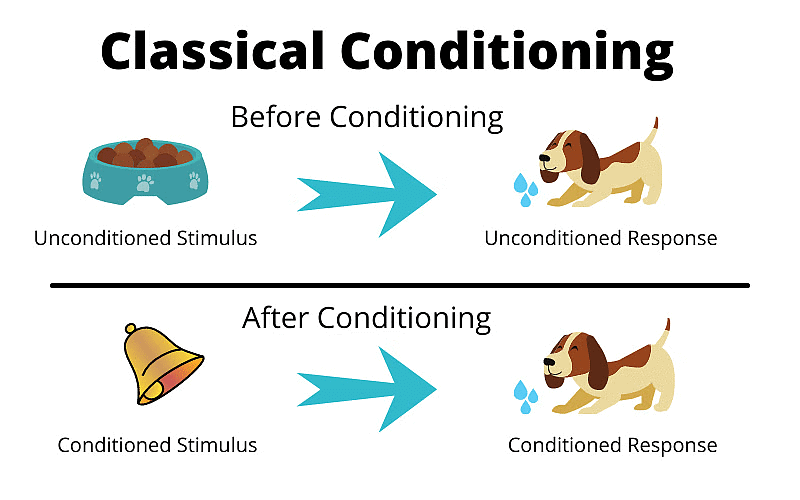
2. Observational Learning in Attitude Formation
- Observational learning occurs when individuals acquire attitudes by observing and imitating others' attitudes and behaviors.
- Example: Children often adopt attitudes similar to those of their parents or other influential figures in their lives whom they admire. This process is driven by the desire to emulate admired individuals and is a key mechanism in social learning theory.
3. Operant Conditioning in Attitude Formation
- Operant conditioning involves learning through rewards and punishments for behaviors.
- Positive Reinforcement Example: Children might develop positive attitudes towards completing tasks like homework if they receive praise or rewards from parents or teachers.
- Negative Reinforcement Example: Conversely, negative attitudes can form if behaviors are associated with punishments or adverse consequences, discouraging the repetition of those behaviors.
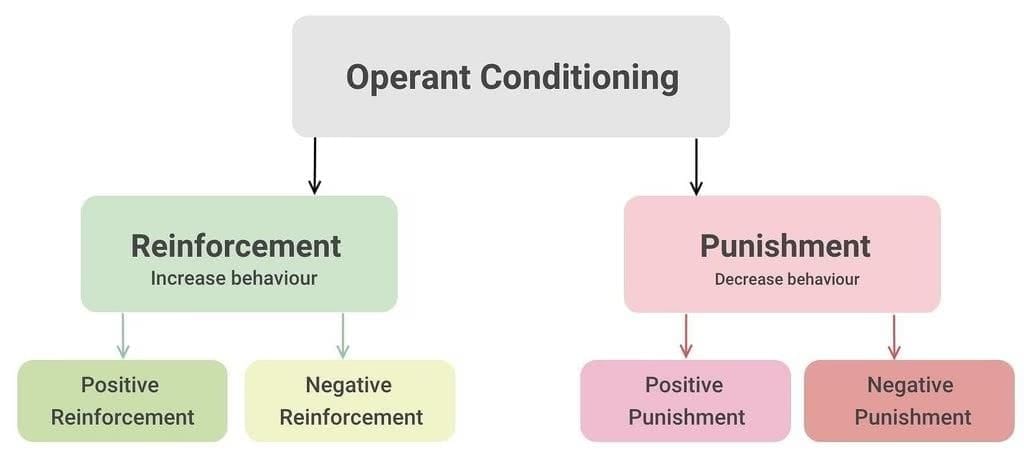
Application of Operant Conditioning in Attitude Formation
- Positive Attitude Development: Children may develop positive attitudes through reinforcement for behaviors that align with desired values or outcomes.
- Negative Attitude Development: Conversely, negative attitudes can develop when behaviors lead to negative consequences or lack of reinforcement.
4. Instrumental Conditioning in Attitude Formation
- Attitudes can be shaped by rewards or punishments associated with specific behaviors.
- Example: Positive attitudes towards respect for elders can be reinforced through consistent rewards for respectful behavior.
5. Social Learning in Attitude Formation
- Attitudes are acquired by observing and imitating others' behaviors and attitudes.
- Factors influencing adoption:
- Likeability of the observed person.
- Consequences (reward or punishment) faced by the observed person for their behavior.
- Example: Observing others receiving punishment for traffic violations can lead to the adoption of attitudes favoring rule-following.
Influence of Attitude on Behaviour
People behave following their attitudes. Our attitudes develop over time and reflect where we have come from and how we will proceed with our life in the future. Therefore, attitudes are a powerful element in our life, are long enduring and hard to change easily.
However, attitudes and actual behaviours are not always perfectly aligned. The degree of influence begins with the assumption that we behave following our conscious intentions. They are based, on our rational calculations about the potential effects of our attitude towards our behaviour and about how other people will feel about it.
People are more likely to behave according to their attitudes under certain conditions such as _
- When our attitudes are the result of personal experience.
- When we are an expert in the subject.
- When we expect a favourable outcome.
- When the attitudes are repeatedly expressed.
- When we stand to win or lose something due to the issue.
In some cases, people may actually alter their attitudes in order to align them with their behaviours better.
Cognitive dissonance is a phenomenon in which a person experiences psychological distress due to conflicting thoughts or beliefs. In order to reduce this tension, people may change their attitudes to reflect their other beliefs or actual behaviours.
Theories of Attitude Change
Attitudes are dynamic and influences which form the attitude can also change the attitude. Thus, there are three theories on change of attitude:
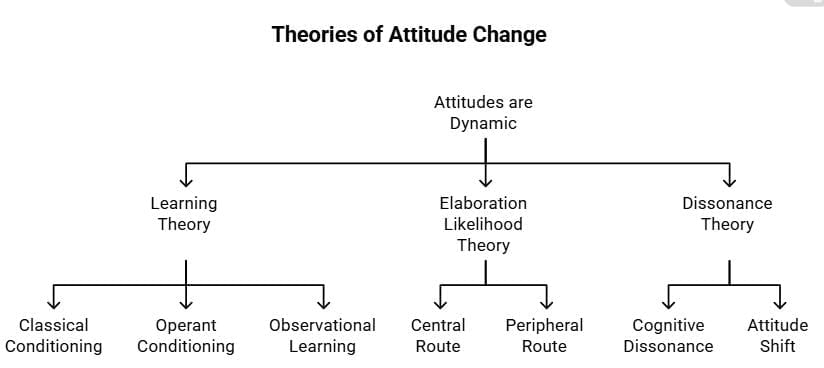
- Learning Theory of Attitude Change
Classical conditioning, operant conditioning and observational learning can be used to bring about attitude change. Classical conditioning can be used to create positive emotional reactions to an object, person or event by associating positive feelings with the target object. Operant conditioning can be used to strengthen desirable attitudes and weaken undesirable ones. People can also change their attitudes after observing the behaviours of others. - Elaboration Likelihood Theory of Attitude Change
This theory of persuasion suggests that people can alter their attitudes in two ways. First, they can be motivated to listen and think about the message, thus leading to an attitude shift. Or, they might be influenced by the speaker's characteristics, leading to a temporary or surface shift in attitude. Messages that are thought-provoking and that appeal to logic are more likely to lead to permanent changes in attitudes. - Dissonance Theory of Attitude Change
As mentioned earlier, people can also change their attitudes when they have conflicting beliefs about a topic. In order to reduce the tension created by these incompatible beliefs, people often shift their perspectives.
Persuasion
Persuasion is the process of influencing someone's beliefs, attitudes, intentions, motivations, or behaviors towards an event, idea, object, or person.
- Scope: It involves using spoken or written words to convey information, feelings, reasoning, or a combination thereof.
- Applications: Commonly used in various contexts such as election campaigning, sales pitches, and trial advocacy.
- Purpose: Often employed to achieve personal gain or to influence others' behaviors and attitudes.
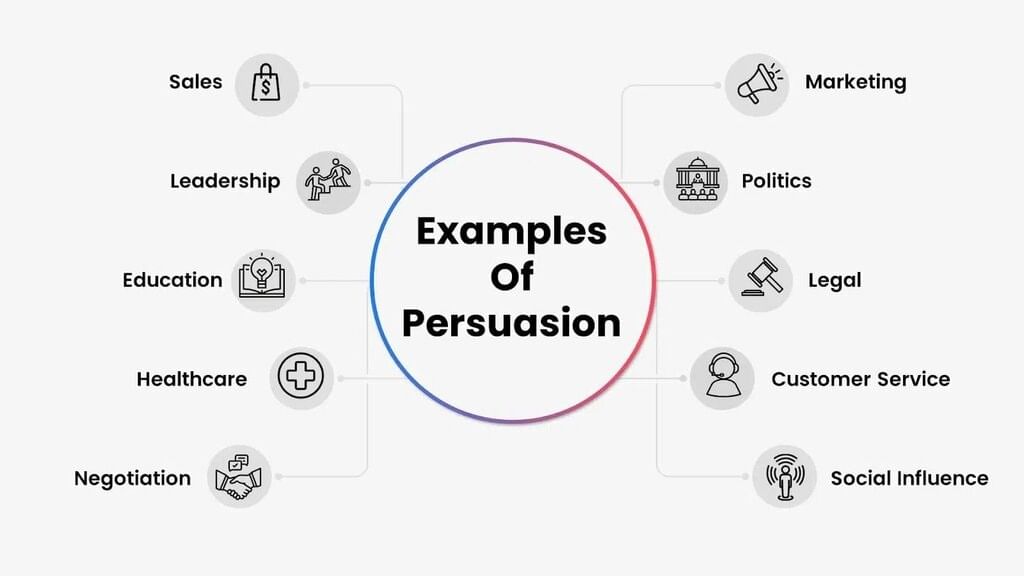
Functions that can be Performed with Persuasion
The persuader needs to select a purpose that is realistic for his/her audience.
Five general purposes of persuasion are listed below.
- Create uncertainty: When an audience is strongly opposed to the persuader's view, the best that may be possible for the persuader is to make the audience a little less certain they are right, a little less comfortable with their current attitude.
- Reduce resistance: If the audience is moderately opposed to the persuader's position but not closed-minded, the persuader may be able to reduce opposition to his/her view and move the audience toward neutrality. While not expecting a reversal of views this goal asks the audience to recognize the validity of opinions different from their own.
- Change attitude: If the audience is not committed, especially strongly, to any attitude on the topic this goal is appropriate.
- Amplify attitude: If the audience is already moderately favourable to the persuader's view, he/she can design a message which will reinforce current attitudes in the audience, help the audience resist appeals from opponents, and motivate the members of the audience to become strongly committed to his/her position.
- Gain behaviour: When an audience strongly favours the persuader's position, the logical goal is to get them to act on their convictions.
Systematic persuasion is the process through which appeals leverage attitudes or beliefs to logic and reason. Heuristic persuasion, on the other hand, appeals to habit or emotion leverage the process through which attitudes or beliefs.
Steps in Persuasion Process

- Establish credibility: Credibility grows out of expertise and relationships. A persuader needs strong emotional characteristics and integrity. The need to listen carefully to other people's suggestions and establish an atmosphere where their opinions are valued.
- Framing common goal with colleagues: Effective persuader must be adept at describing the position in terms that illuminate the person's point advantages that he/ she is trying to persuade. It is a process of identifying shared benefits. This requires conversations to collect essential information by asking thoughtful questions. This process will often prompt to alter the initial argument or include compromises.
- Reinforce positions with vivid language and compelling evidence: Persuasion requires presentation of evidence — strong data in multiple forms (stories, graphs, images, metaphors and examples). Persuaders need to make positions come alive by using vivid language that complements graphics.
- Connecting emotionally with audiences: Good persuaders are aware of primacy of emotions and are responsive to them. They know how to maintain a balance between professionalism and their own emotional commitment to their advocating position. Their connection to their audience demonstrates both intellectual and emotional commitment to their position.
Successful persuaders cultivate an accurate sense of their audience's emotional state, and they adjust their arguments accordingly. Whatever their position, they must match their emotional fervour to their audience's ability to receive their message.
Effective Persuasion
Everyone is susceptible to being persuaded; persuasion is a process whose objective is to change a person's attitude and/or behaviour towards an idea, event, person or an object. Broadly speaking effective persuasion should have desirable source (having credibility), desirable message characteristics (having fear, rational, and emotional appeals). In more detail, persuasion to be effective must have following things:
- Establish a common ground: The persuader should establish positive rapport with target people.
- Point out the benefits: Persuader should highlight the major benefits of changed behaviour or attitude. However, the persuader should avoid trying to push for the change, as it will make him look desperate.
- Turn objections into strengths: Objections to change are natural but the persuader should turn them into opportunities. For this he may agree with the prospect's objection and then illustrate how the proposed change easily overcomes it.
- Commitment and consistency: Persuader should try to get the target section (prospect) to believe in something small or take a small action first. Once committed, the prospect will most likely agree to a larger idea later. This technique employs the fact that people tend to behave consistently, once they take a stand, they will act in ways consistent to the decision as a means of defending and justifying it. Rationality commands an innate appeal to the human mind.
- Use the reciprocity principle: The principle implies that when someone does something for us we feel obliged to return the favour. This may include appropriately rewarding the target population for the changed behaviour/attitude. This helps in strengthening and sustaining the change.
- Social proof technique: People tend to follow others (bandwagon effect) more so when they don't have sufficient information to make the decision on their own. This technique will involve you telling the target population that other people are getting benefits from the suggested change, with empirical evidence. For this the persuader may invoke the examples of some well-known personality. For example, in campaigning against female feticide in Haryana we may invoke the examples of some female sportspersons who have won laurels, S. Nehwal in Badminton, or Kangana Ranaut in Bollywood etc.
- Scarcity: This involves letting people know that they stand to lose on a chance to get the benefits out of the proposed change.
|
78 videos|138 docs
|
FAQs on Attitude: Ethics- 1 - UPSC Mains: Ethics, Integrity & Aptitude
| 1. Why is it important to cultivate the right attitude in our lives? |  |
| 2. What is the process of attitude change? |  |
| 3. What are the steps in the persuasion process? |  |
| 4. How can ethics play a role in shaping attitudes? |  |
| 5. How does attitude impact one's performance in exams like UPSC? |  |

















